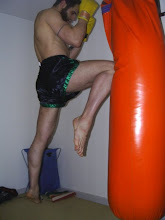 Iaido means the immediate reaction on the metal way or in a direct translation, Iizasa Ienao founded Iaijutsu which later was changed to Iaido.
Iaido means the immediate reaction on the metal way or in a direct translation, Iizasa Ienao founded Iaijutsu which later was changed to Iaido.Iaido is normally often mistaken as a part of kendo or kenjutsu but infact it is a totally different thing. Iaido is associated with the smooth and controlled movements of drawing the blade, with immediate reaction cutting an opponent and removing the blood before replacing the blade back into the scabbard.
Normally students or Iaidoka will use a shinken (unshapened blade) but there are also Dojos that use the real thing on their practices, while new students only uses a boken. The teachings are based on 90% of Katas, please do correct me if I’m wrong, the Katas can have up to a few imaginary opponents but there is no sparing or combative competition for Iaido.
It is quite hard to find a pure Iaido dojo, normally it is shared between Kendo or Akido and even it’s uniform are similliar which consists of Gi and Hakama.
Iaido is very much confused with kendo or kenjutsu and the difference for, Kendo is that kendokas are not taught the techniques of drawing and replacing blade back to it’s scabbard and also Kendo has sparing sessions as well as using Shinai, Boken and Metal Blade. Where else Kenjutsu are normally practiced with a partner in a form of Kata which is quite similar to Iaido except the partner part.
 I really like the part of Japanese Martial Arts and the way they show respect to a lot of stuffs like the Dojo and your sparing partner, this image is a normal procedure that was practiced to show respect to the blade before and after practice.
I really like the part of Japanese Martial Arts and the way they show respect to a lot of stuffs like the Dojo and your sparing partner, this image is a normal procedure that was practiced to show respect to the blade before and after practice.Image Taken from: www.onlinedojo.ca












A shinken is not unsharpened, quite the opposite. You mean a mogito.
ReplyDeleteFew points: Shinken is sharp, i think that you mean Iaito which is unsharp sword.
ReplyDeleteIai is indeed "immediate reaction" bur more importatn it's immediate and right reaction.
And Iaijitsu was originaly part of Kenjistsu
A few pedantic details relating to swords :o)
ReplyDeleteAs poited out earlier, most students use an iaito/mogito. This is an unsharpened 'mock' sword. The higher quality iaito (can cost $1000s) will represent a real katana in terms of weight and balance. If made in Japan iaito are of a non-ferrous (no iron) alloy (typically aluminium, zinc et c.). This is because in Japan only traditionally made shinken or katana (forged and folded many many times from carbon steel and razor sharp) are permitted to be ferrous (either antiques, or modern if made by registered swordsmiths and limited to a strict quota, usually $10,000s). Stainless steel iaito are most often made in China (as are many cheaper carbon steel shinken, available in various degrees of forged, folded and polished states, e.g. the work of Paul Chen). Some iaito are now available with a Chinese stainless steel blade in Japanese fittings. Whilst these are very nice swords, foreign iaidoka would not be allowed to take them into Japan. Conversely, non-ferrous alloy iaito are now available from Paul Chen, reflecting the growing international market for quality swords as iaido becomes ever more popular.
In my opinion, whilst Chinese made swords (iaito and shinken) are available in a very high quality of workmanship/materials, they rarely represent the subtleties of form found in Japanese iaito/shinken. Partcularly the way the curve of the tsuka (handle) follows on from the curve of the blade. However, details like this would only be of significance to very serious/experienced iaidoka.
Great introduction, And don't forget always check your pins and fitting before you practice! safety first.
ReplyDeleteIf anyone is interested, our Sensei is in from Tokyo this July. We study a rare form of iai called Jigen ryu. Very fast, very aggressive.
ReplyDeletehttp://www.facebook.com/event.php?eid=99017987585